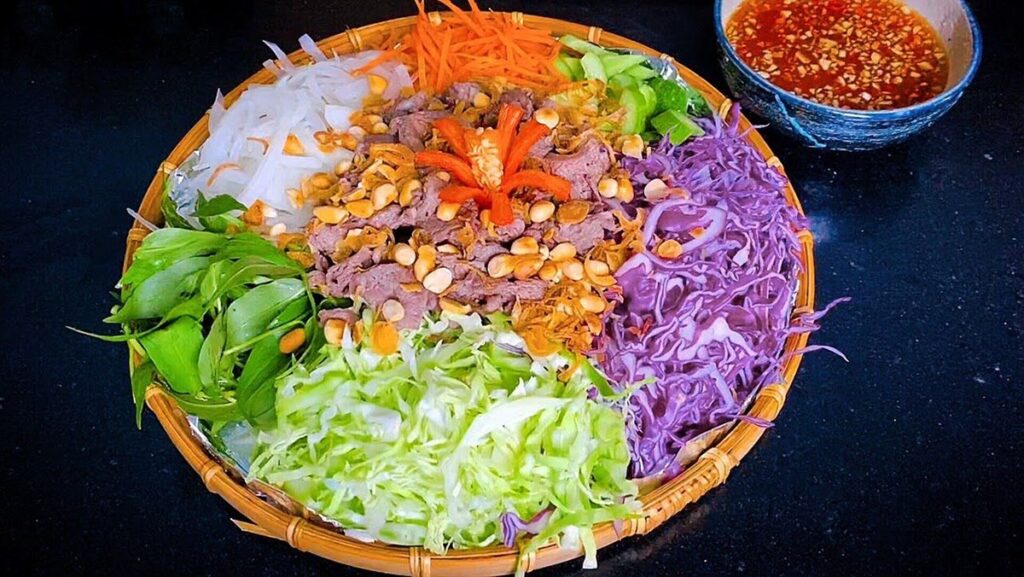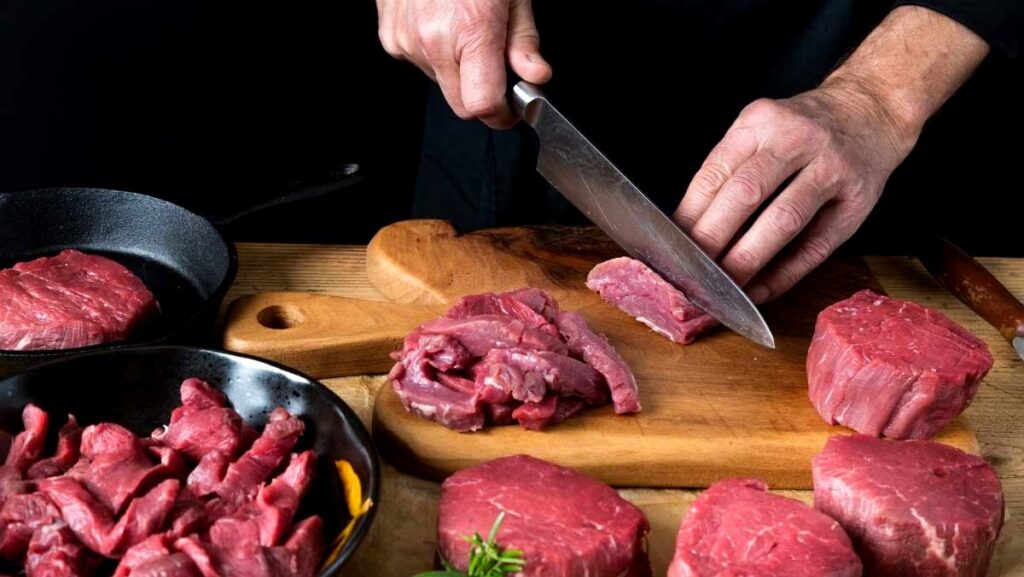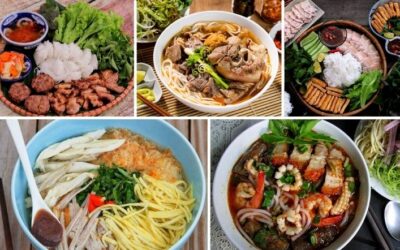Explore Vietnamese cuisine and its Yin Yang philosophy. Discover ngũ vị, ngũ sắc, ngũ tạng, ngũ giác, and ngũ chất. Learn more about rich flavors and vibrant colors.
Discover the essence of Vietnamese cuisine through the Five-Element Correspondence: ngũ vị (flavors), ngũ sắc (colors), ngũ tạng (organs), ngũ giác (senses), and ngũ chất (elements). These principles showcase the harmony, flavors, and colors that make Vietnamese cuisine exceptional.
Table of Contents
Ngũ Vị: The Five Flavors
The first element of the five-element correspondence is ngũ vị, which refers to the five fundamental flavors in Vietnamese cuisine. These flavors are considered essential for achieving a well-balanced meal. They are:
Ngọt (Sweet): Sweet flavors are derived from ingredients such as sugar, fruits, and certain vegetables. They provide a pleasant taste and are believed to nourish the spleen and promote energy.
Chua (Sour): Sour flavors can be found in ingredients like vinegar, citrus fruits, and fermented foods. They stimulate the appetite, aid digestion, and have a cooling effect on the body.
Mặn (Salty): Salty flavors come from salt and various salty condiments. They enhance the taste of dishes, balance other flavors, and support kidney function.
Cay (Spicy): Spicy flavors are achieved through ingredients like chili peppers, ginger, and garlic. They add heat and pungency to dishes, stimulate circulation, and promote sweating.
Đắng (Bitter): Bitter flavors are present in certain herbs, vegetables like bitter melon, and dark chocolate. They aid in digestion, and detoxification, and are believed to have a cooling effect on the body.
Ngũ Sắc: The Five Colors

Vietnamese cuisine is known for its visually appealing and vibrant presentation, which is represented by ngũ sắc, the five colors. Each color is associated with specific elements and holds symbolic meaning:
Xanh (Green): Green represents wood and is associated with freshness, growth, and vitality. It is found in herbs, leafy vegetables, and green fruits.
Đỏ (Red): Red symbolizes fire and is linked to passion, energy, and good fortune. It is seen in ingredients like chili peppers, tomatoes, and red meat.
Vàng (Yellow): Yellow represents earth and is associated with warmth, stability, and nourishment. It can be found in turmeric, yellow fruits, and certain grains.
Trắng (White): White symbolizes metal and is connected to purity, clarity, and cleanliness. Ingredients like rice, noodles, and coconut milk contribute to this color.
Đen (Black): Black represents water and is associated with mystery, depth, and sophistication. Black sesame seeds, mushrooms, and certain sauces contribute to this color.
Ngũ Tạng: The Five Organs
Ngũ tạng refers to the five organs in Vietnamese cuisine, which are believed to correspond to the five flavors and play a crucial role in maintaining balance and harmony within the body. These organs are:
Tạng Tâm (Heart): The heart represents the fire element and is associated with emotions, joy, and vitality. It is believed to be nourished by foods with sweet flavors.
Tạng Phế (Lungs): The lungs correspond to the metal element and are associated with breath, inspiration, and purity. Foods with pungent flavors are believed to support lung health.
Tạng Thận (Kidneys): The kidneys represent the water element and are associated with vitality, reproduction, and wisdom. Salty flavors are believed to nourish the kidneys.
Tạng Phủ (Liver): The liver corresponds to the wood element and is associated with detoxification, energy distribution, and creativity. Bitter flavors are believed to support liver function.
Tạng Vị (Spleen): The spleen represents the earth element and is associated with digestion, transformation, and grounding. Foods with sour flavors are believed to support spleen health.
Ngũ Giác: The Five Senses
In Vietnamese cuisine, ngũ giác emphasizes the sensory experience and the importance of engaging all five senses when enjoying a meal. Let’s explore how each sense is incorporated:
Thị Giác (Sight): Vietnamese dishes are visually enticing, incorporating vibrant colors and artistic presentation to stimulate the sense of sight. The use of fresh herbs, colorful vegetables, and garnishes adds to the aesthetic appeal.
Vị Giác (Taste): As we discussed earlier, the five flavors (ngũ vị) in Vietnamese cuisine create a harmonious blend of tastes that cater to various preferences and promote a well-rounded dining experience.
Khứu Giác (Smell): Fragrant aromas play a crucial role in Vietnamese cuisine. Herbs, spices, and cooking techniques infuse dishes with enticing scents, enhancing the overall enjoyment of the meal.
Thính Giác (Sound): While the sound may not be directly related to taste, the sizzling of ingredients, the crunch of fresh vegetables, or the bubbling of broth contribute to the sensory experience and add an extra layer of enjoyment.
Xúc Giác (Touch): The texture of Vietnamese dishes is diverse and ranges from crispy spring rolls to tender meats and velvety soups. The interplay of different textures provides a delightful tactile experience.

Ngũ Chất: The Five Elements
Lastly, ngũ chất represents the five elements that Vietnamese cuisine encompasses. These elements are:
Mộc (Wood): Wood represents growth, vitality, and flexibility. It is seen in the abundance of fresh herbs, vegetables, and fruits that form the foundation of many Vietnamese dishes.
Hoả (Fire): Fire symbolizes passion, energy, and transformation. It is embodied in the intense flavors achieved through grilling, stir-frying, and the use of spices and chili peppers.
Thổ (Earth): Earth signifies stability, nourishment, and grounding. It is reflected in the variety of grains, rice, and vegetables that form the staple components of Vietnamese meals.
Kim (Metal): Metal represents purity, clarity, and refinement. It is evident in the meticulous preparation and presentation of dishes, as well as the use of utensils and cookware made of metal.
Thủy (Water): Water symbolizes fluidity, adaptability, and balance. It is represented in the broths, soups, and seafood that are integral parts of Vietnamese cuisine, providing hydration, nourishment, and a sense of harmony.
Vietnamese cuisine is more than just delicious food—it reflects the deep-rooted beliefs and philosophy of Vietnam. The Yin Yang concept and the five-element correspondence give Vietnamese culinary traditions meaning and depth.
From the balanced flavors to the vibrant colors, Vietnamese cuisine pleases the senses and creates a harmonious dining experience. The connection between flavors and organs promotes overall well-being, while engaging all five senses ensures an enjoyable meal.
Explore dynamic Vietnamese, business Vietnamese, survival Vietnamese, pronunciation, and cultural courses tailored to different levels. VLS also offers corporate training programs and teacher training courses.
Contact VLS at contact@vlstudies.com or visit their offices in Ho Chi Minh City. Begin your journey with VLS and open doors to a world of Vietnamese language and cultural experiences.




